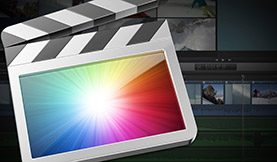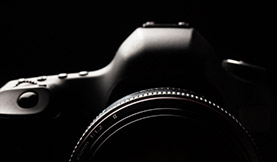Video Tutorial: How to Mark and Edit Clips in FCP X
The arrival of FCP X has brought about massive changes in editing on the Final Cut platform. Even the simplest of procedures, like marking clips and editing them into the Timeline have seen significant transformations. This video tutorial will show you what you need to know in order to get started editing in FCP X.
This Final Cut Pro X video tutorial will teach you how to:
- Navigate the clips in the Event Browser
- Mark IN and OUT points
- Insert edit clips to primary storyline
- Overwrite edit clips to primary storyline
- Append edit to primary storyline
- Connect clips to primary storyline
Full Video Transcription
Hello. This is Ashley Kennedy from Premiumbeat.com here to show you how to mark and edit clips into the timeline in Final Cut Pro X, a process that is greatly changed from Final Cut Pro 7. So in Final Cut Pro 7, we had the Viewer which was located about right here and the Browser, which was located here and the timeline which was right here. Now in Final Cut Pro X, we don’t have the Viewer, we have the Event Library, where we have all of our clips and we’re going to be previewing them over here. And I want to talk about exactly how to mark clips and then how to edit them into the timeline using some techniques we knew in final Cut Pro 7 and a couple of new ones.
So first of all, I want to make sure that we’re aware of what the Playhead, is and what our Skimmer is. As you see here, we have the Playhead right here and the picture likewise shows here, and if I grab my mouse through this clip without clicking down, just hovering this is the Skimmer, so I’m actually able to preview this clip without the Playhead moving. And I can then go on to other clips and sort of get in a good idea of the footage that I have. But my Playhead doesn’t actually move. If I drag my mouse away, the image that we see is still the Playhead image. OK. So how do we mark clips? Well, as you see here, we have a yellow outline around this clip and this yellow outline is going to dictate exactly what part of the clip is edited in the timeline. Now you might think well, I have to drag this and then drag this and then that’s going to be the part of the clip that I edit into the timeline. But in my opinion, there’s actually a better way.
You can navigate through this clips in the same way that you did in Final Cut Pro 7 using JKL. If I hit L once I go forward in real time. If I hit J once I go backwards in real time. If I hit K, I pause. And then I and O, my In and Out points, allow me to mark the clip. So I’m going to go forward with L, and then when I want to mark my endpoint I’m going to hit I, as I just did and when I want my out point, I’m going to let it hit the second reeling here, I’ll hit O. So now I’ve marked my clip using JKL and I and O, which is something we’re familiar with. And I can always play this from in to out using the forward slash key, which is the same key that the question mark is on. Let’s go ahead and select another clip and go over a couple more things about marking clips. Now, if I’d like to see this clip in greater detail, I can either drag this to the left, which will then turn my thumbnail view into more of a film strip view. Or I can come over to List View and you can see this clip is selected and I have the ability to look at my entire clip by Skimming, or by using JKL. And so, if I go forward with L and mark an end, remember I can go forward faster by hitting L again, and my out point with O. If I want to go to my endpoint, I can press Shift I. If I want to go to my Outpoint, I can press Shift O.
All right. Now let’s talk about how to get these clips into the timeline. Now, from Final Cut Pro 7, we’re used to the commands Insert and Overwrite, which are both available in Final Cut Pro X. There’s a couple more that we’ll go over as well. To find all of the available commands, you can go up to the Edit menu and then right here in the middle. We’re going to look at these four. Connect to primary storyline, which keyboard shortcut is Q. Insert is W. Append the storyline is E. And Overwrite is D. So we’re already familiar with Insert and Overwrite, we just have a couple more to go over. Three of these have user interface shortcuts right here. This is Connect to storyline, this is Insert and this is Append. OK. So we’ve marked our clip. We’re ready to insert it into the timeline. Again, the keyboard shortcut for insert is W so I’m just going to press the W key, and we have both the video and the audio edited into the timeline. And the reason that we have both video and audio edited is that All is selected in this drop down instead of video only or audio only.
So let me just load another clip and let’s mark this one. Go ahead and mark an end point and forward with L and my out point, and we’ll go ahead and press W again. Again, if you’re at the end of the sequence and insert just adds material to the end. But if we’re in between two clips or at the beginning of the timeline, then I load another clip, and we’ll mark an in and an out. when we’re insert in this case by pressing W, the clip gets inserted and everything else gets pushed downstream. If I want to move between clips and snap to the transitions between my edits, I can just press the down arrow key and the up arrow key. So if I want to insert a shot into the second and third shot, I can just come up, grab another clip, mark my in and my out, and press W to insert. OK. So we’ve added four shots fairly quickly by using insert and the next thing I want to show you is how to append. OK. So as you see, my playhead is right here in between shots 3 and 4. And, by the way, if you hear the skimming as you go through, that means audio skimming is on. You can always turn it off by going up to view and unchecking audio skimming. So now when we go through timeline, we don’t hear anything. So we’re in between clips 3 and 4 and let’s load another one and mark in, and an out. And instead of having to bring the playhead to the end of the sequence, I can just press append and it will automatically go there. So again, our keyboard shortcut for append is E and you can think of End for E and so I’m just going to hit E and even though my playhead was right here, the shot got appended to the sequence and so it’s at the end.
So that one’s fairly simple. Let’s now talk about overwrite, which, again, was a Final Cut Pro 7 function. Usually, an overwrite is executed by performing a three point edit and usually two of those edit points are in the timeline. So if I wanted to put a shot that starts here, I can mark an in and if I wanted to end here, I can mark an out and I want the shot to overwrite a portion of the sequence. I’ll go ahead and switch back to my thumbnail view and we’ll go ahead and overwrite a portion of this shot into this sequence. Again, three marks makes an edit, so we already have two marks in the sequence and we’ll just mark an endpoint right here and we’ll perform our overwrite which again, the keyboard shortcut is D. So I’ll press the D key and now you can see that that shot was overwritten right here in the timeline, where I had my in and out point set. So it basically behaves the same, once you get the hang of putting your in and out points in your clips in the event library, it’s pretty similar. Now, you may look at this and say “There’s only one track. In Final Cut Pro 7, I was used to having many, many tracks.” Well, it is true that Final Cut Pro X does function within the parameters of this one track. But, without getting too deep into that, what I do want to show you is how you can do video only edits, audio only edits and how to put video over audio.
So let’s just say we want to take the audio from this shot here and put the video of another shot over it. I’m just going to select the portion of this shot, change my edit type to audio only and then I’ll just append this to the timeline by pressing E and let’s go ahead and grab this shot here and we’ll mark the portion of this shot that we want to use. OK. And we’ll change this to video only and then I need to bring my playhead back to the beginning of this shot and instead of inserting or overwriting, what I’m going to do is choose connect to primary storyline, or Q. So if I hit Q, you can see that this shot is now connected to this shot. I can go ahead and drag this in so they’re the same length. But the cool part about this is that when I move one, the other one goes with it, so they are connected or married. And because Final Cut Pro X does use this one track, you can see why this command is important. OK then. So we’ve covered marking our clips with in and out points, as well as inserting clips, appending clips to the end of the sequence, overwriting clips and connecting clips to the primary storyline. Final Cut Pro X editing techniques do go much deeper than this but this gives you a good base to build from going forward. OK. Thanks so much for watching. Make sure to check back on PremiumBeat.com again, for many more tutorials on editing with both Avid and Final Cut Pro. This is Ashley Kennedy with Premiumbeat.com.





